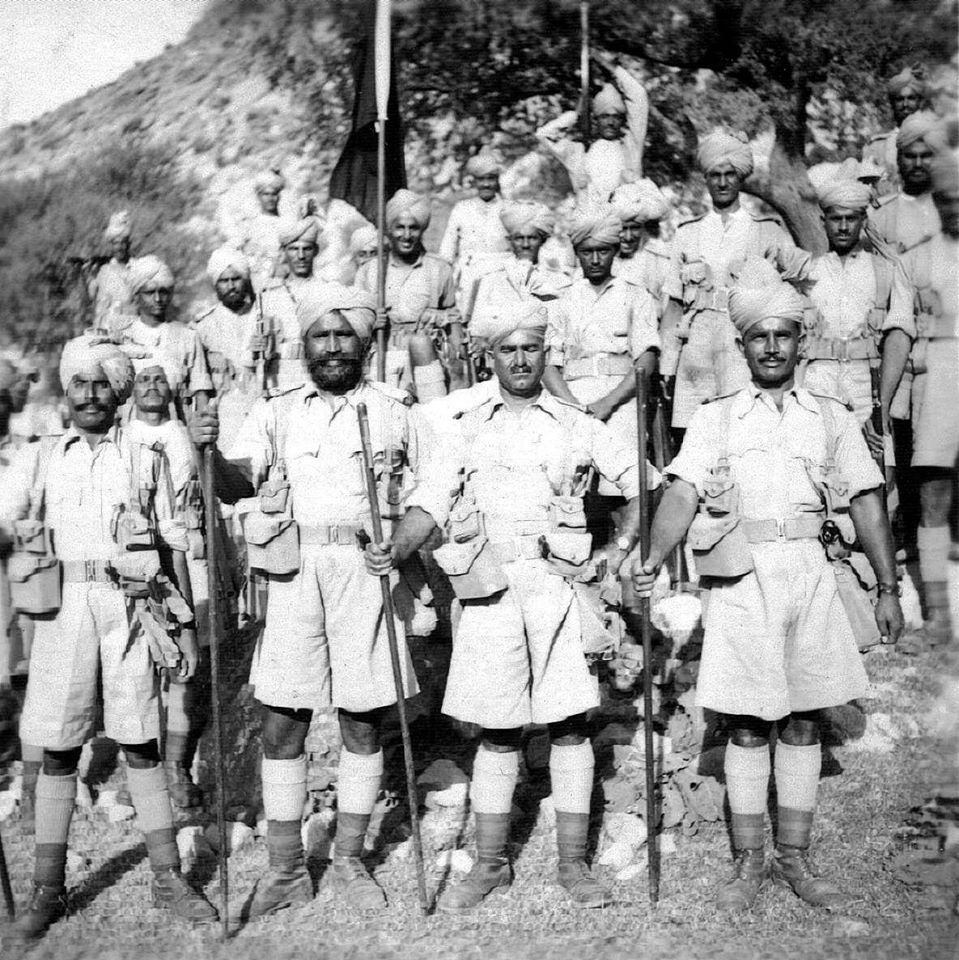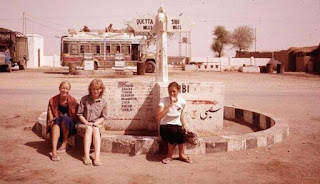Historic photos of every continent and country of the world.See the world's history through photos.
Monday, 6 June 2016
Pashtuns of Pakistan
4)
It
represented a non-violent freedom struggle against the British Empire
by the Pashtuns of the North West Frontier Province(Pukhtunistan).
Sunday, 5 June 2016
Pakistan From Jinnah To Bhutto
31) Jamming:
A pop band of Pakistani Christians performing at Karachi’s Horseshoe
Club & Restaurant in 1974. The club closed down in 1977 and then the
restaurant in the early 1980s.
Pakistan From Jinnah To Bhutto
29)Akbar lives: A vibrant 1973 poster printed by the Pakistan Ministry of Tourism to attract tourism to the city of Lahore.
Pakistan From Jinnah To Bhutto
27)Homage to the founder: Especially struck coins issued on the 100th birth anniversary of Mohammad Ali Jinnah in 1976.
Pakistan From Jinnah To Bhutto
26) A
new blue: A blue PIA aircraft. These limited-edition blue planes were
especially commissioned for flights over Europe in 1977. PIA was still
one of the leading airlines in the world before its gradual decline from
the mid-1980s onwards.
Pakistan From Jinnah To Bhutto
24) Raunchy:
A still from Pakistan’s first ‘X-rated’ film, ‘Dhulan Aik Raat Ki’
(1975) that starred ‘Pakistan’s Charles Bronson’, Badar Munir.
Pakistan From Jinnah To Bhutto
23) The magic bus: European tourists wait for a bus in Pakistan’s arid Balochistan province in 1975.
Pakistan From Jinnah To Bhutto
22) Nightlife:
Victoria Road in the Saddar area of Karachi in 1974. Between 1960 and
1977, the area was a famous for its trendy shops, restaurants and bars.
Pakistan From Jinnah To Bhutto
16)
Walking
tall: Stewardesses of Pakistan International Airline (PIA) on the
runaway of Karachi Airport (in 1960). The uniforms of PIA hostesses were
at the time designed by famous French designer, Pierre Cardin. PIA
became one of the top 10 airlines of the world till it began its slow
decline from the early 1980s onwards.
Pakistan From Jinnah To Bhutto
12)
That
little green drink: The first bottle of Pakistan’s ‘national soft
drink,’ Pakola. The drink was launched by Mehran Bottlers on Pakistan’s
third anniversary on August 14, 1950. Shape of the bottle has gone
through many changes, but the colour and taste of the drink remains the
same: Foggy green and bitter-sweet.
Pakistan From Jinnah To Bhutto
9) Wake
me up when Kashmir’s free: A man takes a nap in the backseat of a car
with a poster demanding the liberation of Kashmir (from India) in
Karachi (1956).
Pakistan From Jinnah To Bhutto
5)
Strongmen:
President Ayub Khan with legendary Pakistani wrestlers, the ‘Bholu
Brothers’ at the Presidency in 1967. The Brothers were considered to be
some of the finest wrestlers in the world at the time.
Strongmen: President Ayub Khan with legendary Pakistani wrestlers, the ‘Bholu Brothers’ at the Presidency in 1967. The Brothers were considered to be some of the finest wrestlers in the world at the time.
Strongmen: President Ayub Khan with legendary Pakistani wrestlers, the ‘Bholu Brothers’ at the Presidency in 1967. The Brothers were considered to be some of the finest wrestlers in the world at the time.
Pakistan From Jinnah To Bhutto
4)
A
1964 press ad about Filipino and Moroccan dancers performing at the
‘007 Club’ at Karachi’s Beach Luxury’s Hotel. The Club is now a
conventional restaurant (but still called 007).
A 1964 press ad about Filipino and Moroccan dancers performing at the ‘007 Club’ at Karachi’s Beach Luxury’s Hotel. The Club is now a conventional restaurant (but still called 007).
A 1964 press ad about Filipino and Moroccan dancers performing at the ‘007 Club’ at Karachi’s Beach Luxury’s Hotel. The Club is now a conventional restaurant (but still called 007).
Pakistan From Jinnah To Bhutto
3) ZA
Bhutto signing a portrait of himself in 1975. His populist regime
(1971-77) tried to blend socialism with democratic populism and certain
aspects of Political Islam. Under him, the Pakistan Ideology meant a
national evolution towards creating a state and nation that was
progressive and multicultural, driven by egalitarian notions of Islam
and an aggressive stance against India. He was toppled in 1977 in a military coup and then hanged (through a controversial trial) in 1979.
ZA Bhutto signing a portrait of himself in 1975. His populist regime (1971-77) tried to blend socialism with democratic populism and certain aspects of Political Islam. Under him, the Pakistan Ideology meant a national evolution towards creating a state and nation that was progressive and multicultural, driven by egalitarian notions of Islam and an aggressive stance against India. He was toppled in 1977 in a military coup and then hanged (through a controversial trial) in 1979.
ZA Bhutto signing a portrait of himself in 1975. His populist regime (1971-77) tried to blend socialism with democratic populism and certain aspects of Political Islam. Under him, the Pakistan Ideology meant a national evolution towards creating a state and nation that was progressive and multicultural, driven by egalitarian notions of Islam and an aggressive stance against India. He was toppled in 1977 in a military coup and then hanged (through a controversial trial) in 1979.
Pakistan From Jinnah To Bhutto
1) The
founder: Jinnah is seen as a progressive and pragmatic man by the left
and the liberal intelligentsia of Pakistan who envisioned a
multicultural Muslim-majority state; whereas the right understands him
to be the man who provided the stepping stone from where Pakistan should
have jumped to create an Islamic State.
The founder: Jinnah is seen as a progressive and pragmatic man by the left and the liberal intelligentsia of Pakistan who envisioned a multicultural Muslim-majority state; whereas the right understands him to be the man who provided the stepping stone from where Pakistan should have jumped to create an Islamic State.
The founder: Jinnah is seen as a progressive and pragmatic man by the left and the liberal intelligentsia of Pakistan who envisioned a multicultural Muslim-majority state; whereas the right understands him to be the man who provided the stepping stone from where Pakistan should have jumped to create an Islamic State.
PAKISTAN 80-90
16)
PAKISTAN-CRIME-PUNISHMENT
Residents of Pakistan's southern port city of Karachi watch as the bodies of three bandits who allegedly tried to rob a house burn after they were set on fire by an angry mob in a street, in Karachi on May 14, 2008. The city police said two of the three alleged robbers burnt by the angry mob died on the spot while the third succumbed to wounds at a hospital later. City police Chief Babar Khattak said the incident showed increasing violent behaviour within the society and any case against those responsible for the act would be decided after a police inquiry. AFP PHOTO (Photo credit should read STRDEL/AFP/Getty Images)
Residents of Pakistan's southern port city of Karachi watch as the bodies of three bandits who allegedly tried to rob a house burn after they were set on fire by an angry mob in a street, in Karachi on May 14, 2008. The city police said two of the three alleged robbers burnt by the angry mob died on the spot while the third succumbed to wounds at a hospital later. City police Chief Babar Khattak said the incident showed increasing violent behaviour within the society and any case against those responsible for the act would be decided after a police inquiry. AFP PHOTO (Photo credit should read STRDEL/AFP/Getty Images)
Subscribe to:
Comments (Atom)

















































